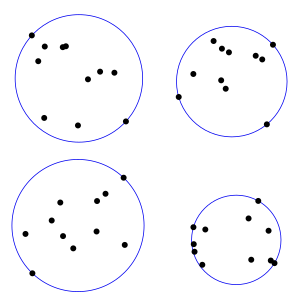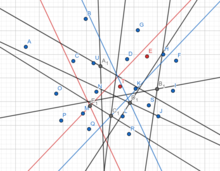|
Smallest-circle problem The smallest-circle problem (also known as minimum covering circle problem, bounding circle problem, least bounding circle problem, smallest enclosing circle problem) is a computational geometry problem of computing the smallest circle that contains all of a given set of points in the Euclidean plane. The corresponding problem in n-dimensional space, the smallest bounding sphere problem, is to compute the smallest n-sphere that contains all of a given set of points.[1] The smallest-circle problem was initially proposed by the English mathematician James Joseph Sylvester in 1857.[2] The smallest-circle problem in the plane is an example of a facility location problem (the 1-center problem) in which the location of a new facility must be chosen to provide service to a number of customers, minimizing the farthest distance that any customer must travel to reach the new facility.[3] Both the smallest circle problem in the plane, and the smallest bounding sphere problem in any higher-dimensional space of bounded dimension are solvable in worst-case linear time. CharacterizationMost of the geometric approaches for the problem look for points that lie on the boundary of the minimum circle and are based on the following simple facts:
Linear-time solutionsAs Nimrod Megiddo showed,[5] the minimum enclosing circle can be found in linear time, and the same linear time bound also applies to the smallest enclosing sphere in Euclidean spaces of any constant dimension. His article also gives a brief overview of earlier and algorithms;[6] in doing so, Megiddo demonstrated that Shamos and Hoey's conjecture – that a solution to the smallest-circle problem was computable in at best – was false.[7] Emo Welzl[8] proposed a simple randomized algorithm for the minimum covering circle problem that runs in expected time , based on a linear programming algorithm of Raimund Seidel. Subsequently, the smallest-circle problem was included in a general class of LP-type problems that can be solved by algorithms like Welzl's based on linear programming. As a consequence of membership in this class, it was shown that the dependence on the dimension of the constant factor in the time bound, which was factorial for Seidel's method, could be reduced to subexponential.[6] Welzl's minidisk algorithm has been extended to handle Bregman divergences[9] which include the squared Euclidean distance. Megiddo's algorithm Megiddo's algorithm[10] is based on the technique called prune and search, reducing the size of the problem by removing unnecessary points. That leads to the recurrence giving . The algorithm is rather complicated and it is reflected by its big multiplicative constant. The reduction needs to solve twice the similar problem where the center of the sought-after enclosing circle is constrained to lie on a given line. The solution of the subproblem is either the solution of the unconstrained problem or it is used to determine the half-plane where the unconstrained solution center is located. The points to be discarded are found as follows: The points Pi are arranged into pairs which defines lines pj as their bisectors. The median average pm of bisectors in order by their directions (oriented to the same half-plane determined by bisector p1) is found and pairs of bisectors are made, such that in each pair one bisector has direction at most pm and the other at least pm (direction p1 could be considered as − or + according our needs.) Let Qk be the intersection of the bisectors in the k-th pair. The line q in the p1 direction is placed to go through an intersection Qx such that there are intersections in each half-plane defined by the line (median position). The constrained version of the enclosing problem is run on the line q' which determines half-plane where the center is located. The line q′ in the pm direction is placed to go through an intersection Qx' such that there are intersections in each half of the half-plane not containing the solution. The constrained version of the enclosing problem is run on line q′ which together with q determines the quadrant where the center is located. We consider the points Qk in the quadrant not contained in a half-plane containing the solution. One of the bisectors of the pair defining Qk has the direction ensuring which of points Pi defining the bisector is closer to each point in the quadrant containing the center of the enclosing circle. This point could be discarded. The constrained version of the algorithm is also solved by the prune and search technique, but reducing the problem size by removal of points leading to recurrence giving . The points to be discarded are found as follows: Points Pi are arranged into pairs. For each pair, the intersection Qj of its bisector with the constraining line q is found (If this intersection does not exist we could remove one point from the pair immediately). The median M of points Qj on the line q is found and in O(n) time is determined which halfline of q starting in M contains the solution of the constrained problem. We consider points Qj from the other half. We know which of the points Pi defining Qj is closer to the each point of the halfline containing center of the enclosing circle of the constrained problem solution. This point could be discarded. The half-plane where the unconstrained solution lies could be determined by the points Pi on the boundary of the constrained circle solution. (The first and last point on the circle in each half-plane suffice. If the center belongs to their convex hull, it is unconstrained solution, otherwise the direction to the nearest edge determines the half-plane of the unconstrained solution.) Welzl's algorithmThe algorithm is recursive. The initial input is a set P of points. The algorithm selects one point p randomly and uniformly from P, and recursively finds the minimal circle containing P – {p}, i.e. all of the other points in P except p. If the returned circle also encloses p, it is the minimal circle for the whole of P and is returned. Otherwise, point p must lie on the boundary of the result circle. It recurses, but with the set R of points known to be on the boundary as an additional parameter. The recursion terminates when P is empty, and a solution can be found from the points in R: for 0 or 1 points the solution is trivial, for 2 points the minimal circle has its center at the midpoint between the two points, and for 3 points the circle is the circumcircle of the triangle described by the points. (In three dimensions, 4 points require the calculation of the circumsphere of a tetrahedron.) Recursion can also terminate when R has size 3 (in 2D, or 4 in 3D) because the remaining points in P must lie within the circle described by R. algorithm welzl is[8] input: Finite sets P and R of points in the plane |R| ≤ 3. output: Minimal disk enclosing P with R on the boundary. if P is empty or |R| = 3 then return trivial(R) choose p in P (randomly and uniformly) D := welzl(P − {p}, R) if p is in D then return D return welzl(P − {p}, R ∪ {p}) Welzl's paper states that it is sufficient to randomly permute the input at the start, rather than performing independently random choices of p on each recursion. It also states that performance is improved by dynamically re-ordering the points so that those that are found to be outside a circle are subsequently considered earlier, but this requires a change in the structure of the algorithm to store P as a "global". Other algorithmsPrior to Megiddo's result showing that the smallest-circle problem may be solved in linear time, several algorithms of higher complexity appeared in the literature. A naive algorithm solves the problem in time O(n4) by testing the circles determined by all pairs and triples of points.
Weighted variants of the problemThe weighted version of the minimum covering circle problem takes as input a set of points in a Euclidean space, each with weights; the goal is to find a single point that minimizes the maximum weighted distance (i.e., distance multiplied by the corresponding weight) to any point. The original (unweighted) minimum covering circle problem corresponds to the case when all weights are equal to 1. As with the unweighted problem, the weighted problem may be solved in linear time in any space of bounded dimension, using approaches closely related to bounded dimension linear programming algorithms, although slower algorithms are again frequent in the literature.[16][19][20] Smallest enclosing balls in non-Euclidean geometryThe smallest enclosing ball of a finite point set has been studied in Riemannian geometry including Cartan-Hadamard manifolds.[21] See also
References
External links
|





















